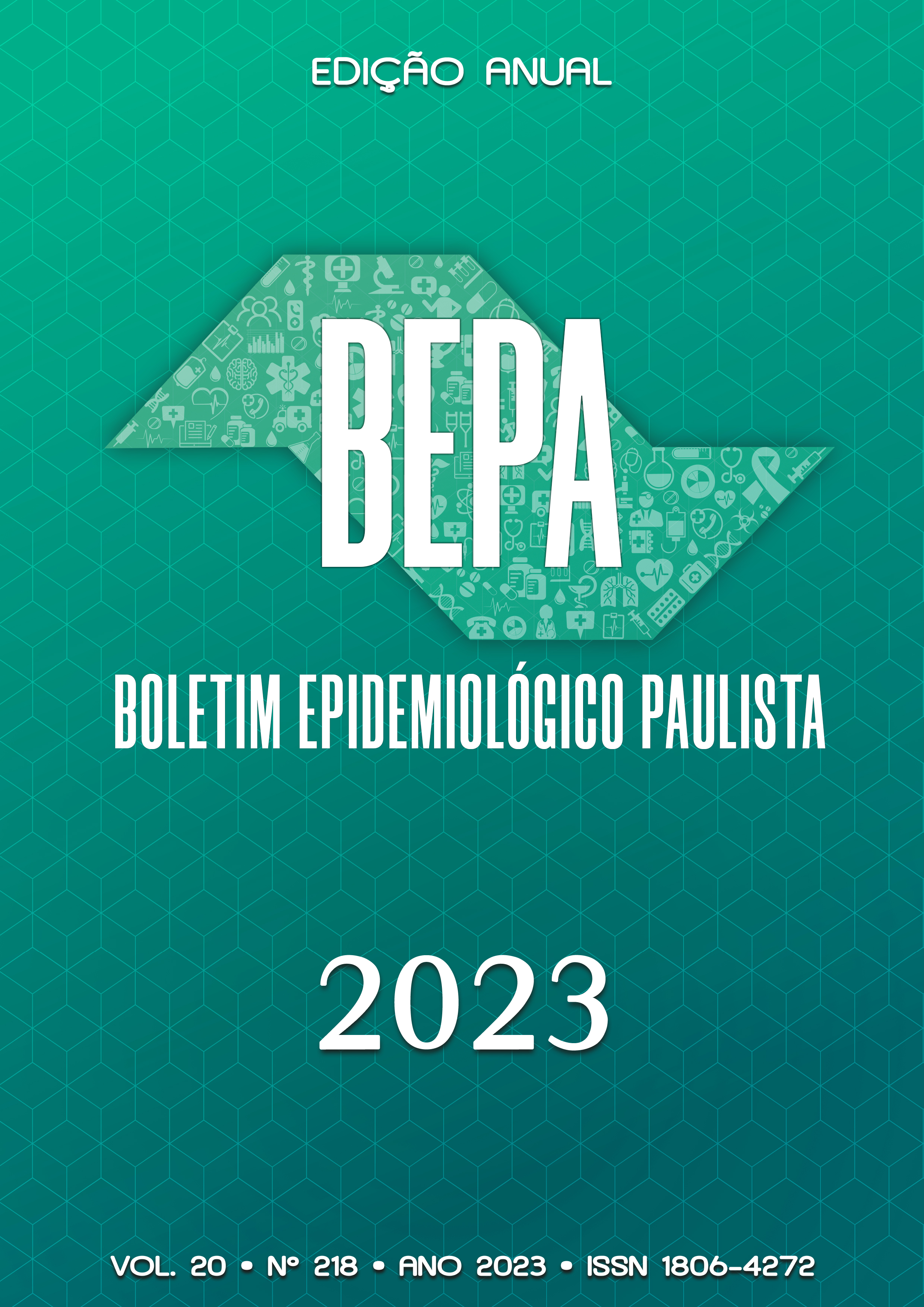Abstract
Sporotrichosis is a zoonosis caused by fungus of the genus Sporothrix. These fungi are usually present in the environment, soil and decomposition vegetation. Non-zoonotic infection occurs through traumatic inoculation of the etiological agent during the handling of contaminated soil, plants or natural organic matter. Currently, this is still a possible route of transmission, but zoonotic transmission is increasingly standing out, and human sporotrichosis is often related to scratching or biting animals, especially the domestic cat (Felis catus). In São Paulo, the Divisão de Vigilância em Zoonoses (DVZ) and the Unidades de Vigilância em Saúde (UVIS) are the municipal agencies responsible for the surveillance, prevention, and control of this zoonosis. The aim of this study is to draw the epidemiological profile of domestic cats with sporotrichosis in the city of São Paulo in 2020. The total of feline cases was 1,050 of which 653 were confirmed diagnoses of which 76% have free access to the outside. Adult, male and non-sterilized cats, due to their behavioral and exploratory habits, are more exposed to infection. Regarding the anatomical location of fungal lesions, the most frequent regions were: head (58.35%), thoracic limb (34.76%), body (28.33%) and snout (27.72%). Therefore, keeping cats indoors is an important point in preventing new cases. We suggest that future analyzes be carried out at least one year after notification/beginning of treatment for better monitoring of the cohort.
References
LARSSON CE. Dermatopatias fúngicas-Esporotricose. In: Larsson CE, Lucas R. Tratado de Medicina Externa: Dermatologia Veterinária. Interbook, 2016. p. 295-306.
GREMIÃO IDF, MIRANDA LM, REIS EG, RODRIGUES AM, PEREIRA SA. Zoonotic Epidemic of Sporotrichosis: Cat to Human Transmission. PLOS Pathogens, v. 13, n.1, 2017.
MACEDO-SALES PA, SOUTO SRLS, DESTEFANI CA, LUCENA RP, MACHADO RLD et al.; Domestic feline contribution in the transmission of Sporothrix in Rio de Janeiro State, Brazil: a comparison between infected and noninfected populations. BMC Veterinary Research. 2018 Jan 18;14(1):19. Disponível em: https://www.ncbi.nlm.nih.gov/pubmed/29347940 doi: 10.1186/s12917-018-1340- 4.
SÃO PAULO. Lei estadual Nº 12.916, DE 16 DE ABRIL DE 2008. Disponivel em: <https://www.al.sp.gov.br/repositorio/legislacao/lei/2008/lei-12916-16.04.2008.html>
BARROS MBL, SCHUBACH TP, COLL JO, GREMIÃO ID, WANKE B, SCHUBACH A. 2010. Esporotricose: a evolução e os desafios de uma epidemia. Revista Panamamerica de Salud Publica. 27(6):455-460.
LARSSON CE (2011). Sporotrichosis. Brazilian Journal of Veterinary Research and Animal Science, 48(3), 250-259.
BARROS MB, ALMEIDA PAES R, SCHUBACH AO. Sporothrix schenckii and Sporotrichosis. Clinical Microbiology Reviews 2011; 24:633-654.
SCHUBACH A, BARROS MB, WANKE B. Epidemic sporotrichosis. Current Opinion in Infectious Diseases 2008; 21:129-133.
SILVA, EA, BERNARDI F, MENDES MCNC, PARANHOS NT, SCHOENDORFER LMP et al. Surto de esporotricose em gatos – investigação e ações de controle, município de São Paulo/SP. Boletim Epidemiológico Paulista, Janeiro, 2015, v.12, ed.133. Disponível em: http://www.saude.sp.gov.br/resources/ccd/homepage/bepa/edicao- 2015/edicao_133_-_janeiro.pdf
SILVA EA, Bernardi F, Mendes MCN, Ferreira AAMB, Montenegro H. Esporotricose: situação na cidade de São Paulo e a importância do clínico veterinário na vigilância dessa zoonose. Boletim APAMVET, VOLUME 10 • Nº 1 • 2019. Disponível em: <https://publicacoes.apamvet.com.br/PDFs/Artigos/83.pdf>
SÃO PAULO. Portaria Nº 470/2020-SMS.G, de 01 de dezembro de 2020. Diário Oficial da Cidade, São Paulo, SP, 2020, p.25.
LARSSON, C.E.; SILVA, E. A.; BERNARDI, F. Esporotricose. Série Zoonoses - CRMVSP. 2021. 2. Disponivel em: <https://crmvsp.gov.br/wp-content/uploads/2021/02/ESPOROTRICOSE_SERIE_ZOONOSES.pdf>.
WHO, World Health Organization. WHO Director-General's opening remarks at the media briefing on COVID-19 - 11 March 2020. Acesso em: 02 de jan. de 2022. Disponivel em: <https://www.who.int/director-general/speeches/detail/who-director-general-s-opening-remarks-at-the-media-briefing-on-covid-19---11-march-2020>
Brasil. Ministério da Saúde. Secretaria de Vigilância em Saúde. Departamento de Articulação Estratégica de Vigilância em Saúde. Guia de Vigilância em Saúde [recurso eletrônico] / Ministério da Saúde, Secretaria de Vigilância em Saúde. Departamento de Articulação Estratégica de Vigilância em Saúde. – 5. ed. rev. e atual. – Brasília : Ministério da Saúde, 2022. Disponível em: <https://bvsms.saude.gov.br/bvs/publicacoes/guia_vigilancia_saude_5ed_rev_atual.pdf>
SANTOS AF et al. Practical guide for coping with feline sporotrichosis in Minas Gerais State-Brazil. Revista V&Z Em Minas.Ano XXXVIII. n137.Abr/Mai/Jun 2018
IBGE – INSTITUTO BRASILEIRO DE GEOGRAFIA E ESTATÍSTICA . Censo Brasileiro de 2010. Domicílios, População e Densidade Domiciliar nos Anos de Levantamento Censitário. Município de São Paulo, Subprefeituras e Distritos Municipais 1991, 2000 e 2010. Disponível em: <https://www.prefeitura.sp.gov.br/cidade/secretarias/upload/chamadas/7_domicilios_populacao_e_densidade_domicil_1991_10746_1658412959.htm>.

This work is licensed under a Creative Commons Attribution 4.0 International License.
Copyright (c) 2023 Tadeu Campioni Morone Cardoso, Valéria Gentil Tommaso, Tamara Leite Cortez, Juliana Anaya Sinhorini, Paula Andrea Santis Bastos




